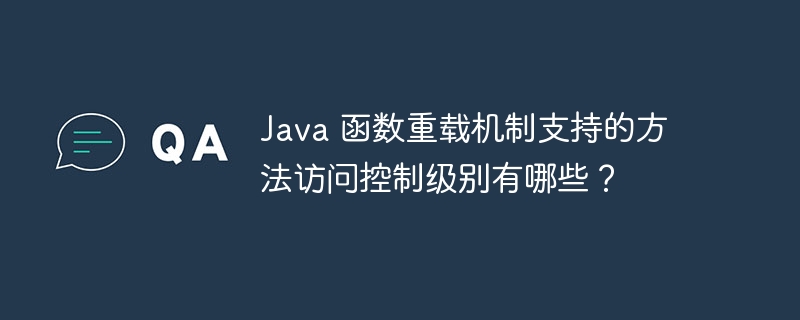 Java
Java
 javaTutorial
javaTutorial
 What are the method access control levels supported by the Java function overloading mechanism?
What are the method access control levels supported by the Java function overloading mechanism?
What are the method access control levels supported by the Java function overloading mechanism?
Java function overloading allows the creation of functions with different signatures but the same name. Visibility is controlled by the access control level, which supports private, package-level private, protected and public. For example, the calculateArea() function can be overloaded to accept a circle or square argument and be accessed from different locations depending on the access control level.

Access control level of Java function overloading
Function overloading in Java allows the definition of multiple functions with the same name but different signatures function. These functions can have different parameter types, number of parameters, and return types. In function overloading, the access control level determines the visibility of different versions of the overloaded method to different packages and classes.
Access control levels supported by Java function overloading
The Java language supports the following access control levels:
- private ): Can only be accessed from within the class in which they are defined.
- Package-private (package-private): Can only be accessed from classes within the package that contains them.
- Protected: Can only be accessed from classes and derived classes in the package that contains them.
- Public (public): Can be accessed from any class.
Practical Case
Consider the following example where the overloaded calculateArea() function accepts values based on shape (circle or square) Different parameters:
public class ShapeCalculator {
public double calculateArea(Circle circle) {
return Math.PI * circle.getRadius() * circle.getRadius();
}
public double calculateArea(Square square) {
return square.getWidth() * square.getWidth();
}
}In this example, we declare two versions of the calculateArea() function:
-
calculateArea(Circle circle )Receives a circular object as a parameter and returns the area of the circle. -
calculateArea(Square square)Receives a square object as a parameter and returns the area of the square.
Both versions of the calculateArea() function can be accessed from any class because they are both declared as public. Therefore, we can use these functions in any of the following locations:
- Classes within the same package
- Classes within different packages
- From the main method
It should be noted that the access control level is also important for overriding and rewriting different versions of overloaded methods. For example, in a subclass, you can only override parent class methods that have the same or broader access control level.
The above is the detailed content of What are the method access control levels supported by the Java function overloading mechanism?. For more information, please follow other related articles on the PHP Chinese website!

Hot AI Tools

Undresser.AI Undress
AI-powered app for creating realistic nude photos

AI Clothes Remover
Online AI tool for removing clothes from photos.

Undress AI Tool
Undress images for free

Clothoff.io
AI clothes remover

AI Hentai Generator
Generate AI Hentai for free.

Hot Article

Hot Tools

Notepad++7.3.1
Easy-to-use and free code editor

SublimeText3 Chinese version
Chinese version, very easy to use

Zend Studio 13.0.1
Powerful PHP integrated development environment

Dreamweaver CS6
Visual web development tools

SublimeText3 Mac version
God-level code editing software (SublimeText3)

Hot Topics
 1359
1359
 52
52
 Square Root in Java
Aug 30, 2024 pm 04:26 PM
Square Root in Java
Aug 30, 2024 pm 04:26 PM
Guide to Square Root in Java. Here we discuss how Square Root works in Java with example and its code implementation respectively.
 Perfect Number in Java
Aug 30, 2024 pm 04:28 PM
Perfect Number in Java
Aug 30, 2024 pm 04:28 PM
Guide to Perfect Number in Java. Here we discuss the Definition, How to check Perfect number in Java?, examples with code implementation.
 Random Number Generator in Java
Aug 30, 2024 pm 04:27 PM
Random Number Generator in Java
Aug 30, 2024 pm 04:27 PM
Guide to Random Number Generator in Java. Here we discuss Functions in Java with examples and two different Generators with ther examples.
 Armstrong Number in Java
Aug 30, 2024 pm 04:26 PM
Armstrong Number in Java
Aug 30, 2024 pm 04:26 PM
Guide to the Armstrong Number in Java. Here we discuss an introduction to Armstrong's number in java along with some of the code.
 Weka in Java
Aug 30, 2024 pm 04:28 PM
Weka in Java
Aug 30, 2024 pm 04:28 PM
Guide to Weka in Java. Here we discuss the Introduction, how to use weka java, the type of platform, and advantages with examples.
 Smith Number in Java
Aug 30, 2024 pm 04:28 PM
Smith Number in Java
Aug 30, 2024 pm 04:28 PM
Guide to Smith Number in Java. Here we discuss the Definition, How to check smith number in Java? example with code implementation.
 Java Spring Interview Questions
Aug 30, 2024 pm 04:29 PM
Java Spring Interview Questions
Aug 30, 2024 pm 04:29 PM
In this article, we have kept the most asked Java Spring Interview Questions with their detailed answers. So that you can crack the interview.
 Break or return from Java 8 stream forEach?
Feb 07, 2025 pm 12:09 PM
Break or return from Java 8 stream forEach?
Feb 07, 2025 pm 12:09 PM
Java 8 introduces the Stream API, providing a powerful and expressive way to process data collections. However, a common question when using Stream is: How to break or return from a forEach operation? Traditional loops allow for early interruption or return, but Stream's forEach method does not directly support this method. This article will explain the reasons and explore alternative methods for implementing premature termination in Stream processing systems. Further reading: Java Stream API improvements Understand Stream forEach The forEach method is a terminal operation that performs one operation on each element in the Stream. Its design intention is



